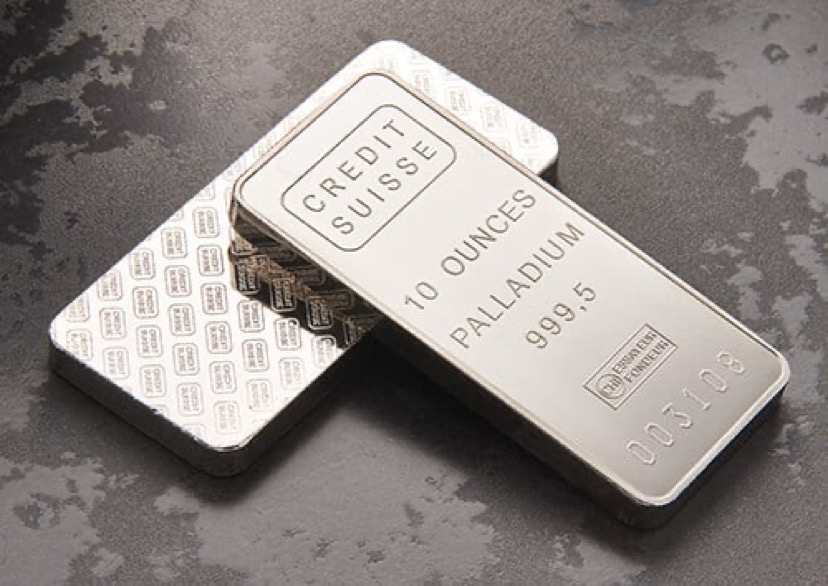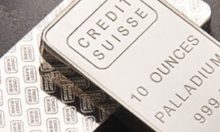
Why Invest in Palladium?
Palladium is a rare, platinum-group metal that is used extensively for industrial purposes. It is also a precious metal that investors value as a safe haven asset and store of value. Of the four main precious metals (gold, silver, platinum, and palladium), palladium is the least understood. Simultaneously, the monetary benefits it provides are appealing to many investors in the modern economy.
With the US dollar facing the inflationary effects of large scale quantitative easing, investors are looking for ways to hedge against the USD. When inflation is a threat, they often turn to precious metals as a way to hold onto their wealth and grow it, despite the falling dollar.
Palladium has become a more popular investment choice in the 21st century and often outperforms gold, silver, and platinum. The precious metal is used extensively in the automotive industry to produce catalytic converters, which decrease carbon emissions. Stricter guidelines for automakers to reduce emissions create a growing demand for palladium. However, it’s also an important metal for jewelry making and in other industries such as dental products and chemical production. Because of its usefulness in these growing industries, palladium has a long term outlook for strong demand.
On the other hand, it is the most scarce of all precious metals, causing it to trade at a premium price over gold and silver. Because of the scarceness, the risks of inflation and sentiment manipulation are much lower than with cash and bond investments.
Production of new palladium is less than 10% of gold, even as palladium demand is rising. This combination of scarcity and demand suggests a strong future outlook for the palladium price, causing investors today to take a long look at this fairly unknown metal.

What drives palladium price?
Palladium has a unique set of features that figure into its price, all relating to supply and demand. Generally, demand refers to the number of buyers who desire something, whereas supply refers to how much the markets can provide to meet that demand. Essentially, when demand for a product increases, prices will see upward movement.
During macro events in 2020, demand for palladium rose dramatically as public transit systems shut down due to the pandemic. This led to an increase in the demand for automobiles that ultimately caused palladium price to reach an all-time high of $2700 per ounce.
The key value proposition of all the precious metals is scarcity (measured by current stores and annual tons mined) relative to demand (investor and industrial). This concept of supply and demand can be a delicate balance. Still, it’s easy to see a clear path of opportunity with palladium due to its distinctive set of circumstances around price discovery.
Palladium’s importance to the automotive and emissions-reducing industry is a primary factor affecting its supply and demand. But geopolitics, palladium’s substitution qualities, and its relation to the US Dollar also play roles in driving palladium price.
Demand from the automotive industry
The auto industry represents almost 75% of palladium’s global demand. As countries pass new laws restricting carbon emissions from automobiles, the demand for catalytic converters rises. Along with it, the need for more palladium, which is a key component in the construction of the converters. Increasing demand for clean energy cars factors into the price of this precious metal. Growing demand is seen particularly in countries with large markets, such as China and the US. When China issues new clean air standards or auto manufacturing declines due to oversupply, you can see the effects of these industry events on palladium price.
Strength of USD
A weakening US Dollar can also impact the price of palladium, similarly to how this type of event affects all precious metals. Palladium is purchased primarily in US Dollars, so suppliers may be less inclined to sell when the USD is in decline. When this happens, the supply can tighten. So when USD price shows downward movement, investors turn to precious metals as a store of value and safe haven, driving demand up for palladium at the same time that supplies are contracting.
Geopolitics
The political atmosphere across the globe affects most markets, including precious metals. Today’s modern economy is globally connected and, in many ways, interdependent.
With palladium, geopolitical events can have a much greater impact on palladium price than we would see with gold or silver. Only two regions, Russia and South Africa, account for the majority of the total palladium supply. Interruptions to any part of the supply process, such as can happen with sanctions or power supply problems, can represent a major influence on how palladium price moves.
Substituting other metals
The high price of palladium can lead to manufacturers seeking out cheaper palladium substitutions, such as platinum. But platinum is not a direct substitute and requires some difficulty to use as a replacement for palladium. Automakers today rely primarily on palladium
since platinum is not a direct substitute, but in the future, they may be looking for more cost-effective alternatives, which could affect palladium’s price.
Abundance is another issue that can lead to substitutions. Palladium is very scarce, and manufacturers may need to source more abundant and readily available substitutions during times of tight palladium supply.
Palladium production
Palladium production depends on other metals, as it is a byproduct of the mining process of alternative metals like platinum and nickel. In this way, the palladium price is connected to and often affected by other metals markets
Ways to invest in palladium
After researching how palladium price fluctuates and all the factors that influence its value, it is time to look towards how to invest. There are many ways to accomplish this, from physical ownership of palladium bullion to investing in futures contracts and many options in between. Each method of investing in palladium offers different pros and cons, so investors can determine which best fits their needs.
Some investors may prefer to hold onto a physical store of palladium and don’t mind having to store and insure their assets. Others, however, may want to hold a paper form of palladium or a certificate of ownership. Then they don’t have the worries of holding onto their physical precious metal.
The more savvy investor may look toward Exchange Traded Funds (ETFs) and futures. Millennials, who are prone to a higher acceptance level of digital currencies, may prefer a palladium-backed stable coin such as Palladium Coin as their choice of investment.
Whichever type you choose will depend on your level of investment experience, your available capital, and your capacity and willingness to store it safely.
Physical palladium
Investing in physical palladium generally means purchasing the precious metal in its different forms. But physical means it’s something tangible. There are three major ways to do this:
- Official government mints in Canada, Russia, Sierra Leone, and the US issue palladium coins that investors can purchase online. When buying physical palladium this way, the value of the metal content has a guarantee of the quality and palladium content from the minting entity.
- Collectible coins also come originally from mints but are often made available to investors from individual sellers. An investor should have some knowledge of how to assess the value of collectibles in order to make a sound investment in this manner.
- Rounds & Bars – Palladium rounds and bars come in different weight sizes. Investors can easily purchase them from government mints or private companies online who mint them for resale.
ETFs
A palladium ETF tracks the price of the precious metal or a basket of assets, including palladium. These types of ETFs are not nearly as common as Gold and Silver ETFs, but there are several that are currently in existence:
- The Aberdeen Standard Physical Palladium Shares fund (PALL) is an ETF which currently has approximately $365.39 million in assets under management. PALL holds physical bullion and is not a derivatives contract. The fund held over 161,500 ounces of palladium in a secured vault as of March 31, 2020. Founded in 2009, PALL has returned over 17% annually since its inception.
- The Sprott Physical Platinum and Palladium Trust (SPPP) tracks prices for palladium and platinum and also has physical bullion in its holdings. It currently has over 24,000 ounces of platinum and 44,000 ounces of palladium. The SPPP has returned 6% annually since its creation in 2012.
- The Aberdeen Standard Physical Precious Metals Basket Shares ETF (GTR) invests in a variety of precious metals, primarily silver. But it also includes some percentage of palladium and platinum bars. The GTR has been notoriously flat since its inception in 2010.
Palladium futures
Futures represent contracts to buy or sell palladium at a future time with a predetermined price. Investing in futures is more complex than simply buying physical palladium or buying shares of a fund. Futures price action since early 2018 and up to 2020 was bullish but has leveled off since that time.
Experienced investors can trade palladium futures at the New York Mercantile Exchange (NYMEX) and the Tokyo Commodity Exchange (TOCOM). At the New York exchange, palladium futures are quoted in USD per ounce and trade in lot sizes of 100 ounces.
Palladium stocks
Another way to gain exposure to palladium is to invest in businesses that have a focus on palladium. This is another complex strategy for palladium investing, especially since the majority of palladium is produced in just a few countries, which limits the businesses that interconnect with the industry. For that reason, it may be hard to find stocks that are appropriate for palladium-only investment purposes.
However, two palladium mining companies in North America are publicly listed:
- Sibanye-Stillwater (NYSE:SBGL)
- North American Palladium (TSX:PDL, OTC Pink: PALDF)
Other public companies offer some (but not full) exposure to palladium, such as Grid Metals (TSVX:GRDM), Ivanhoe Mines (TSX:IVN, OTCQX:IVPAF), and New Age Metals (TSX:NAM, OTCQB:NMTLF).
Digital Stablecoins
One of the newest ways to invest in palladium is by purchasing a stable digital currency backed by palladium stores. With Bitcoin, Ethereum, and other cryptocurrencies gaining massive exposure in recent years, stable coins like Palladium Coin often represent the onramp to further cryptocurrency investing.
A stable coin that is pegged to palladium reserves offers the convenience of buying digitally, the security of blockchain transactions, and the ease of purchasing any incremental amount. With cryptocurrencies, it’s easy and cheap to buy a small amount, thus furthering the democratization of stocks into the digital realm.
A recent study revealed that more than 35% of millennials who were aware of crypto thought it was a good investment. This tech-savvy generation is already highly invested in digital assets, especially compared with older generations. Moving to a stable coin backed by precious metals like palladium will appeal to the millennial’s desire to digitize their money and investments.
Who should invest in palladium?
Every investor is different, and there are many types of palladium investment vehicles to match each investor’s needs and experience level. No matter what level you may be at, palladium represents a precious metal with a proven background of returns and a hopeful future of increasing demand.
Buying bars and coins online from a mint represent the simplest way to invest in palladium and can be done by anyone with a device. Getting in on ETFs and futures may require either strong investment experience or a trusted professional’s help. And investing in palladium stocks is perhaps the most complex form and best left to the trading experts. That leaves investing in a palladium-backed stable coin, which may be the preferred choice of the next generation.
Make an investment in PalladiumCoin
Now that you know more about palladium. Isn’t it a perfect time to buy today?
Purchase PalladiumCoin